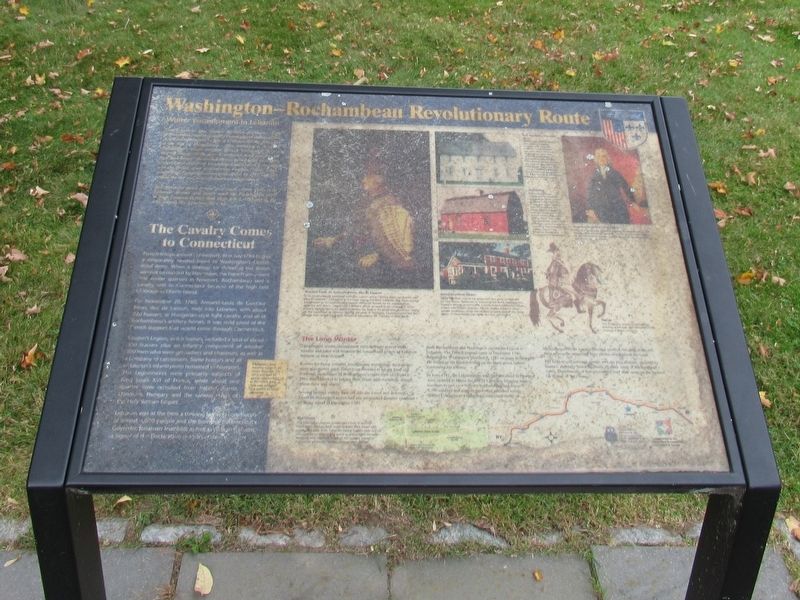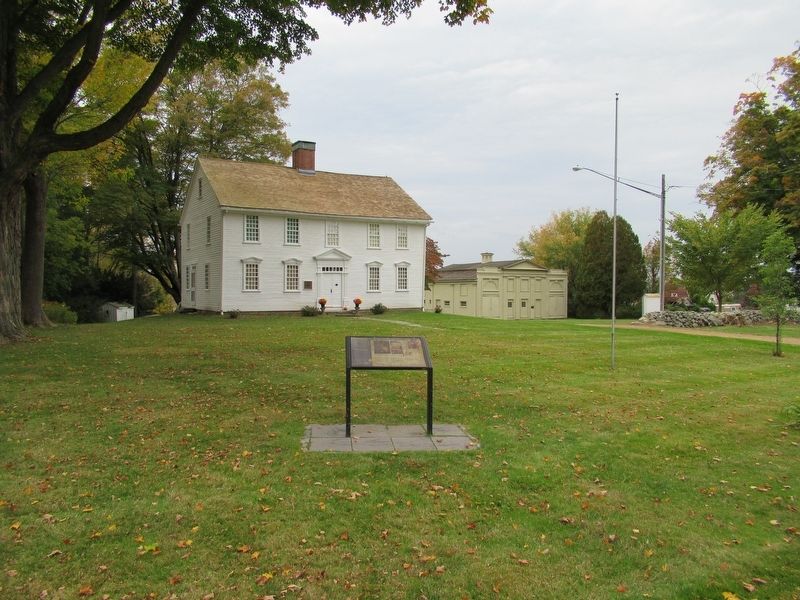Lebanon in New London County, Connecticut — The American Northeast (New England)
Washington-Rochambeau Revolutionary Route
Inscription.
Winter Encampment in Lebanon
French General Jean Baptiste Donatien de Vimeur, comte de Rochambeau, and thousands of French ground and naval forces arrived in Newport in July of 1780 to assist the Americans in the War for Independence. After wintering in Newport, Rochambeau’s troops marched through Connecticut to join General George Washington’s Continental Army just over the New York border. The combined forces moved down the eastern seaboard and confronted Lieutenant General Earl Cornwallis and the British army in Yorktown, Virginia. After a prolonged siege, Cornwallis surrendered on Oct. 19, 1781, virtually ending the war and ensuring American independence.
This narrative panel focuses on French winter quarters in Lebanon. Another nine panels mark the French route south through Connecticut from June 19 to July 2, 1781 and on the return north Oct. 23 to Nov. 11, 1782.
The Cavalry Comes to Connecticut
French troops arrived in Newport, RI in July 1780 to give a desperately needed boost to Washington’s Continental Army. When a strategy for defeating the British was not formalized by November, the French army went into winter quarters in Newport. Rochambeau sent a cavalry unit to Connecticut because of the high cost of forage in Rhode Island.
On November 20, 1780, Armand-Louis de Gontaut Biron, duc de Lauzun, rode into Lebanon with about 220 hussars or Hungarian-style light cavalry, and all of Rochambeau’s artillery horses. It was vivid proof of the French support that would come through Connecticut.
Lauzun's Legion, as it is known, included a total of about 300 hussars plus an infantry component of another 300 men who were grenadiers and chasseurs, as well as a company of cannoniers. Sone hussars and all of Lauzun's infantrymen remained in Newport. The Legionnaires were primarily subjects of King Louis XVI of France, while about one quarter were recruited from Ireland, Russia, Denmark, Hungary and the various states of the Holy Roman Empire.
Lebanon was at the time a thriving farming community of almost 4,000 people and the home of Connecticut’s Governor, Jonathan Trumbull, as well as William Williams, a signer of the Declaration of Independence.
Chasseur: term meaning hunter in the French language. The name was used for certain infantry units in the French Army that were equipped and trained for rapid movement.
Armand-Louis de Gontaut Biron, duc de Lauzun
In his posthumously published memoirs, Lauzun wrote “Siberia alone can furnish any idea of Lebanon.” Compared to the royal courts of France, Lebanon may have seemed a backwater to the sophisticated Lauzun. Although known for his extravagance,
gallantry and charm, Lauzun was a brilliant officer devoted to his troops. His earlier military exploits led to his appointment by the king as the proprietor of his own legion for the expedition to America. During the siege at Yorktown, Lauzun’s Legion led the charge that routed the British hussars at Gloucester, VA. Courtesy of Peter Montz
The Long Winter The planned winter encampment stretched into almost eight months and good will between the hussars and people of Lebanon became at best, strained.
Known for being colorful, troublesome and daring, the hussars were also poorly paid. Some even resorted to taking food and firewood, in defiance of Rochambeau’s strict code of conduct. They also objected to baking their own bread with cornmeal, though wheat flour was scarce.
Several hussars simply took off into the forest and deserted. To set an example, Lauzun had one recaptured deserter executed by firing squad in December, 1780.
Both Rochambeau and Washington visited the Legion in Lebanon. The French general came in December, 1780, followed by Washington March 4-5, 1781 English route to Newport. He reviewed the French troops on the town green before continuing his journey.
In June, 1781, the Legionnaires who had remained in Newport were ordered to rejoin the unit in Lebanon, bringing the total numbers to just over 600. As Rochambeau and some 4,700 soldiers and support personnel marched across central Connecticut to join the Continental Army in Philipsburg, NY, the Legion marched south of the army as the left flank to provide protection from enemy attack from the coast.
The Legion split into two groups with the foot soldiers escorted by hussars, generally marching about 20 miles south of Rochambeau’s Army. Detachments of hussars roamed over wide areas on the lookout for British or Tory forces.
[Captions:
Gov. Jonathan Trumbull House
Military and political leaders who came to Lebanon to confer with Governor Jonathan Trumbull often met with him in his house on the green. Here the governor entertained Rochambeau, Lauzun and other French officers during the Legion’s encampment in Lebanon. The house is now restored, owned by the Connecticut Daughters of the American Revolution. Photo by Grant Huntington
War Office
Governor Jonathan Trumbull held hundreds of meetings of the Council of Safety in his War Office to plan the state’s defense. Here he organized the distribution of supplies for both the Continental and French Armies, leading to Connecticut’s nickname, “The Provision State.” The building is now a museum, owned by the Connecticut Society, Sons of the American Revolution. Photo by Grant Huntington
David Trumbull House
David Trumbull, one of the governor’s four sons, turned over his own house, Redwood, to Lauzun to use as his headquarters. Lauzun’s second in command, Colonel Robert Guillaume Dillon, stayed with William Williams. French officers stayed in other private residences, while the soldiers camped west of the town green. (Private residence) Photo by Grant Huntington
Governor Jonathan Trumbull
Copy of original John Trumbull painting by Albertus Jones, 1923. On loan to Connecticut Daughters of the American Revolution by the Connecticut Society, Sons of the American Revolution. gift of Col. L.A. Cheney
Hussar
This is the only known contemporary drawing of a hussar and dates from 1780. Courtesy of Brown University
The Green
The mile-long Lebanon Green was a hub of activity. The French soldiers built ovens to bake their bread and conducted daily drills. Lebanon-based hussars rode out on reconnaissance patrols and acted as messengers between Newport and Hartford. Some of the hussars stayed in Colchester where the artillery horses were stabled.
Erected by National Washington-Rochambeau Revolutionary Route Association Inc. (W3R-US).
Topics and series. This memorial is listed in this topic list: War, US Revolutionary. In addition, it is included in the Former U.S. Presidents: #01 George Washington, and the The Washington-Rochambeau Route series lists.
Location. 41° 38.186′ N, 72° 12.865′ W. Marker is in Lebanon, Connecticut, in New London County. Memorial is at the intersection of West Town Street and Exeter Road (Connecticut Route 207), on the left when traveling north on West Town Street. Located in front of the John Trumbull Birthplace, across from the Lebanon Green. Touch for map. Marker is at or near this postal address: 169 West Town Street, Lebanon CT 06249, United States of America. Touch for directions.
Other nearby markers. At least 8 other markers are within walking distance of this marker. John Trumbull Birthplace (within shouting distance of this marker); Liberty Hill Church Bell (within shouting distance of this marker); Old Lebanon Meeting House (about 300 feet away, measured in a direct line); Site of Lebanon War Office (about 400 feet away); Founding of Lebanon, Connecticut (about 400 feet away); Lebanon Veterans Monument (about 400 feet away); Lebanon Iraq Afghanistan Veterans Monument (about 500 feet away); a different marker also named Lebanon Veterans Monument (about 500 feet away). Touch for a list and map of all markers in Lebanon.
More about this marker. Weather has affected the clarity of the text and pictures.
Credits. This page was last revised on March 3, 2024. It was originally submitted on October 22, 2016, by Michael Herrick of Southbury, Connecticut. This page has been viewed 595 times since then and 43 times this year. Last updated on February 27, 2024, by Carolyn Sanders of Plano, Texas. Photos: 1, 2. submitted on October 22, 2016, by Michael Herrick of Southbury, Connecticut. • Devry Becker Jones was the editor who published this page.

